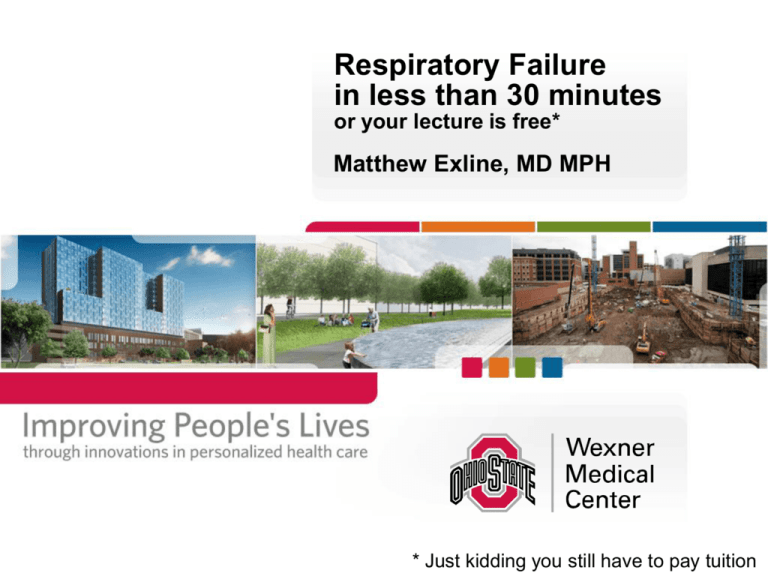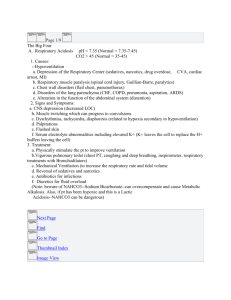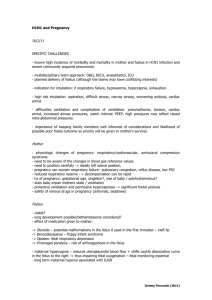What is respiratory failure?
advertisement

Respiratory Failure in less than 30 minutes or your lecture is free* Matthew Exline, MD MPH * Just kidding you still have to pay tuition Learning Objectives Define the mechanisms of hypoxemia. Use A-a gradient to differentiate the cause of hypoxemia in the clinical setting. Recognize depressed respiratory drive, inadequate neuromuscular competence and excessive respiratory system load as causes of ventilatory failure. Describe clinical treatment strategy to improve oxygen delivery based on the oxygen delivery equation. Describe the use of Positive Pressure Ventilation in the treatment of respiratory failure. 2 What is respiratory failure? Hypoxemic: Failure to maintain adequate oxygenation of tissue (Type I Failure) Hypercapnic Failure to remove carbon dioxide from tissue (Type 2 Failure) May be acute, chronic, or acute on chronic Causes of Hypoxia (NEW!) Low partial pressure of oxygen Hypoventilation Impaired diffusion Shunt Increased dead space ventilation Abnormal hemoglobin binding Abnormal mitochondrial usage 4 Alveolar-arterial gradient (REVIEW) Remember A Alveolar oxygen = PAO2 = (PB – PH2O) x %FiO2 - PACO2/R a arterial oxygen = measured with arterial blood gas Normal Values PB ~ 760 mmHg (at sea level) PH2O = 47 mmHg PACO2 = PaCO2 (from blood gas) PAO2 = 100 mmHg PaO2 = 80 mmHg A-a gradient = 0 (perfect lungs) < 20 mmHg (clinical medicine) 5 Causes of Hypercapnia Causes of Hypercapnia (simple version) Inhalation of CO2 Increased production CO2 Fever Increased calories Pump Failure Competence - not enough effort Load – too much work Apollo 13 Carbon Dioxide Scrubbers “I suggest you gentlemen invent a way to put a square peg in a round hole. Rapidly.” Pump Failure? Can you expand on that? CNS (medulla) Peripheral nervous system Competence Respiratory muscles Chest wall Lung Tracheobronchial tree Alveoli Pulmonary vasculature Heart and the peripheral vasculature Load Load versus Neuromuscular Competence Neuromuscular Competence Resistive Loads Bronchospasm Airway edema OSA Depressed Drive Drug Overdose Brainstem Lesion Sleep Disordered Breathing Impaired N-M Transmission Phrenic Nerve Injury Spinal Cord Lesion Neuromuscular Blockers Myasthenia Gravis ALS Muscle Weakness Fatigue Electrolyte Derangement Malnutrition Myopathy Adapted from Murray and Nadel, 1995 9 Lung Elastic Loads Alveolar edema Infection Atelectasis Load Chest Wall Elastic Loads Pleural Effusion Chest wall trauma Obesity Abdominal Distention Minute Volume Loads Sepsis Pulmonary Embolus Detection of Respiratory Failure Examine the patient Oximetry Blood Gas René Laennec Patient Exam “How’s your breathing?” Evaluate mental status Work of breathing Respiratory rate Accessory Muscle Use General signs of distress Abnormal heart rate Abnormal blood pressure Oxygen Saturation 11 CPR Annie How do we measure saturation? The Pulse Oximeter Needed: Finger / Forehead Light Red light (660nm) Infrared light (910nm) Pulse Detection of pulse is how the oximeter subtracts out venous/tissue absorption 12 When can oximeter lead me astray? Apnea Increased work of breathing Inadequate oxygen content Anemia Abnormal hemoglobin binding Methemoglobinemia Carboxyhemoglobin Work of Breathing Keep in mind we are exquisitely sensitive to our respiratory load Straw-breathing Patients with airway obstruction may maintain oxygenation until respiratory collapse Laryngeal edema Tracheal stenosis Tracheal Stenosis Normal Trachea What to I really care about? (REVIEW) Remember oxygen content (CaO2) is a more important management measure than PaO2 ([Hb] * %Sat * 1.34 ml/g) + (PaO2 * 0.003) Oxygen delivery the key parameter CaO2 * Cardiac output (CO) Always correlated your oxygenation status with your clinical picture! Would an ABG be better? An ABG measures: ABG Machine (not to scale) pH, pO2, pCO2 Generally test of choice for detecting hypercapnia An ABG calculates Bicarbonate Oxygen saturation An ABG will miss Carboxyhemoglobin Methemoglobinemia CO-oximetry will detect all 4 forms of Hgb CO-oximetry absorption 16 Final Check of Oxygen Delivery - Lactate Lactate production in health Lactate produced peripherally and converted to pyruvate in the liver – Cori Cycle Evidence of anaerobic metabolism Inadequate oxygen delivery = Respiratory Failure Inadequate oxygen use = mitochondrial dysfunction Will discuss more in Sepsis lecture 17 J Exp Biol 208 4561 2005 Hospital mortality increases with increasing lactate Treatment of Respiratory Failure Hypoxemic Supplemental oxygen Hypercapnic Decrease production CO2 Decrease ventilatory load Improve neuromuscular competence Hypoxemia / Hypercapnia Positive-pressure ventilation Supplemental Oxygen: Nasal Cannula 1-6 LPM *1L=24% *2L=28% *3L=32% *4L=36% *5L=40% *6L=44% **Now “High Flow” Nasal Cannula can deliver up to 15 LPM of oxygen and estimated FIO2 of ~ 80% Advantages and Disadvantages of the Nasal Cannula 20 Advantages: Disadvantages: Comfortable Able to communicate Patient can eat and take oral medications Easy to use at home Nasal obstruction may impede gas flow. May cause nasal mucosal drying (can be humidified with sterile water) Venturi Mask (Venti Mask) 3-15 LPM 24%-50% (set on base of mask) Set FIo2 with percentage markings on the base of mask and adjust the oxygen flow meter the appropriate LPM Rebreather Mask Flow set to 15 LPM Bag should remain 1/31/2 full after the patient takes a deep breath No Valves Partial Rebreather No valves Delivers 60%-80% oxygen Non-Rebreather Valves in place Delivers 90-100% oxygen…maybe 22 Valves Treatment of Respiratory Failure Hypoxemic Supplemental oxygen Hypercapnic Reduce fever Attention to nutrition Decrease production CO2 Decrease ventilatory load Improve neuromuscular competence Hypoxemia / Hypercapnia Positive-pressure ventilation Treatment of Respiratory Failure Hypoxemic Supplemental oxygen Hypercapnic Decrease production CO2 Decrease ventilatory load Improve neuromuscular competence Hypoxemia / Hypercapnia Positive-pressure ventilation Load versus Neuromuscular Competence Neuromuscular Competence Resistive Loads Bronchospasm Airway edema OSA Depressed Drive Drug Overdose Brainstem Lesion Sleep Disordered Breathing Impaired N-M Transmission Phrenic Nerve Injury Spinal Cord Lesion Neuromuscular Blockers Myasthenia Gravis ALS Muscle Weakness Fatigue Electrolyte Derangement Malnutrition Myopathy Adapted from Murray and Nadel, 1995 25 Lung Elastic Loads Alveolar edema Infection Atelectasis Load Chest Wall Elastic Loads Pleural Effusion Chest wall trauma Obesity Abdominal Distention Minute Volume Loads Sepsis Pulmonary Embolus Treatment of Respiratory Failure Hypoxemic Supplemental oxygen Hypercapnic Decrease production CO2 Decrease ventilatory load Improve neuromuscular competence Hypoxemia / Hypercapnia Positive-pressure ventilation When should I use Positive Pressure Ventilation? Respiratory distress with moderate to severe dyspnea use of accessory muscles of respiration, abdominal paradox Increased respiratory rate (~RR 30) or work of breathing Acidosis (~pH < 7.2 to 7.3) Inability to oxygenate (SpO2 < 90%) despite supplemental oxygen * All values are relative Inability to protect airway THIS GUY/GAL IS SICK… Positive Pressure Ventilation Machine CPAP – helps oxygenation BiPAP – helps oxygenation and ventilation “Ventilator” – one stop shop for Respiratory Failure Hospital Ventilator Home CPAP machine Hospital BiPAP machine Positive Pressure Ventilation Interface Mask Face Masks Awake patient, easily removable Endotracheal Tube Patient can be sedated Can be difficult to place Tracheotomy Permanent airway Sedated, mechanically ventilated patient with ET tube “Trach” patient How should I deliver ventilatory support? Non-invasive (CPAP or BiPAP) Awake, cooperative patient Hemodynamically stable Suspected temporary condition COPD exacerbation, CHF exacerbation Use mask and either CPAP is purely oxygenation issue BiPAP if ventilatory support is needed (hypercapnia) How should I deliver ventilatory support? Full mechanical support Patient not protecting airway (coma) Patient delirious, not cooperative Hemodynamically unstable (shock) Expected longer duration of illness > 24 to 48 hours temporary condition Failure of non-invasive ventilation Patient will need endotracheal intubation and mechanical ventilation (aka “life support”) * All values are relative What should I remember from this? Causes of hypoxia Causes of hypercapnia Function and utility of pulse oximeter Approximate FiO2 of supplemental oxygen When to use mechanical ventilation Questions / Comments / Suggestions Please email me: matthew.exline@osumc.edu If you look like this at the end of lecture, go back and restart the slides… Survey We would appreciate your feedback on this module. Click on the button below to complete a brief survey. Your responses and comments will be shared with the module’s author, the LSI EdTech team, and LSI curriculum leaders. We will use your feedback to improve future versions of the module. The survey is both optional and anonymous and should take less than 5 minutes to complete. Survey






